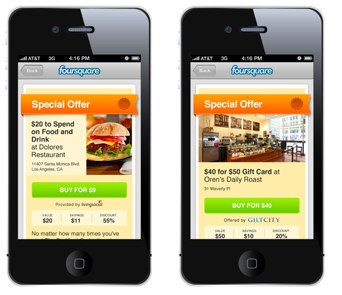Foursquare this morning announced distribution partnerships with daily deal providers LivingSocial, Gilt City, zozi, BuyWithMe and AT&T. Missing from the list are Groupon, Yelp and Google Offers.
With these deals, Foursquare is attempting to solve two problems: liquidity in deals and its own lack of a revenue model.
Foursquare already has a reasonable number of deals on its own. How many, exactly, it refuses to say. But I even found one during a stopover in Ketchikan, Alaska. I couldn’t get a 3G signal, but I could get a Foursquare deal.
Foursquare will now distribute the deals to its users on behalf of its partners. At this stage of the mobile deals market, it helps all of the players out there to work together. None of these companies have all of the pieces of the puzzle: Foursquare has distribution, but no local salesforce. LivingSocial and the others have salesforces and some deals but no meaningful mobile distribution.
Without cooperation, you run into the Color problem—you check to see what’s there, see nothing, check again, see nothing and then stop checking. A single purpose deals app will get old quickly. Deals need to be shown where people already are for other reasons.
Foursquare is one of those outlets. The company won’t disclose how many monthly unique users it has, but I would estimate it at 2-3 million, based on typical Internet decay rates of registered users and its recent milestone of 10 million registered users.
However, I see three key challenges with Foursquare deals:
- Confusion among the various deal types. Foursquare deals already come in many flavors: mayor, newbie, swarm, flash, check in, loyalty and friends. These deals are all processed by the business at point of sale. There are also deals in conjunction with Foursquare’s partnership with American Express at H&M, Sports Authority and Dunkin’ Donuts. With these deals, you pay full price and receive a credit on your credit card statement after the fact. With deal providers like LivingSocial, you have to pay in advance and then redeem the offer. In some cases, you won’t be able to redeem the offer right away—you will have to wait for the deal to close just as daily deals do. For the initial launch, there is no Foursquare wallet. If you buy a deal from LivingSocial one day and enter all your information, you’ll have to repeat the process if you later buy a deal from zozi.
- Competition with itself. This is a rare case where the company actually makes more money if you use competing products than if you use its products. Foursquare’s excellent deal and loyalty products are free to merchants. The daily deal providers charge merchants and then give a revenue share to Foursquare. (The company does not disclose how much.) For merchants, the best value is to use Foursquare’s in-house products.
- Competition with the big guys. Because of massive fragmentation, local is very dependent on a large user base. Foursquare’s scale is tiny compared with Google and Facebook mobile app users. Google claims more than 200 million users across its mobile local properties. Facebook has even more mobile users. Google and Facebook could distribute deals for the deal providers just as they do ads online.
There is also competition between Foursquare and its partners. Tomorrow, LivingSocial is offering $1 lunches at more than 100 places in San Francisco to promote the launch of LivingSocial Instant. I asked LivingSocial if those deals will be available through the Foursquare app.
“Tomorrow’s dollar lunch will only be available thru the LivingSocial apps or the LivingSocial website,” replied spokeswoman Maire Griffin.
In other words, LivingSocial would like you to install their app.
